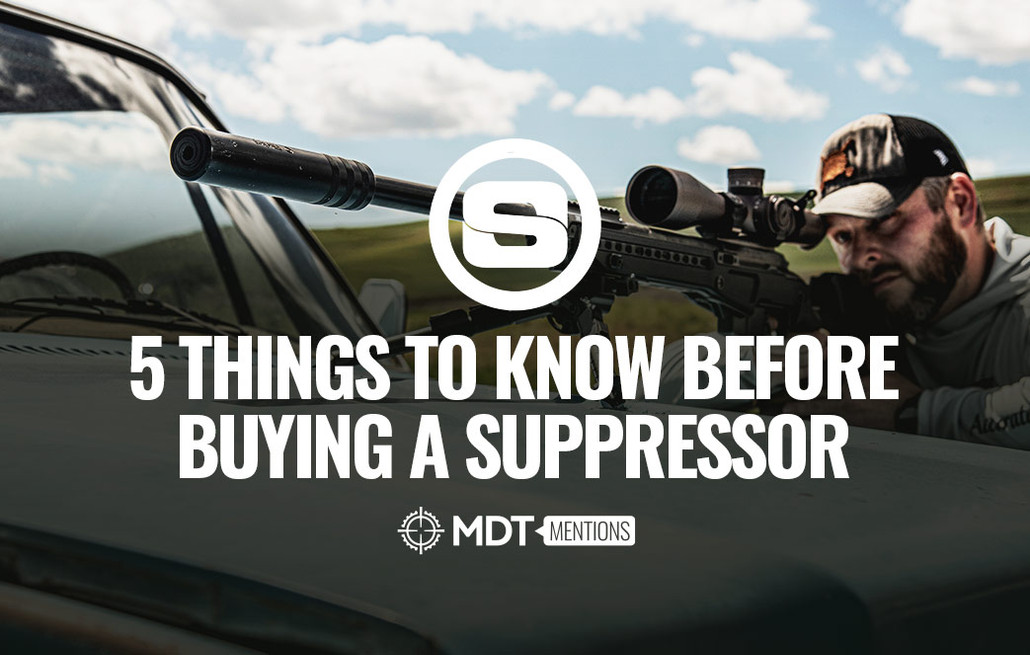Posted by William Maxwell on 2024 Apr 23rd
5 Things to Know Before Buying a Suppressor - MDT Mention
Are you interested in diving into the world of suppressors? Buying your first suppressors can be intimidating due to caliber, uses, material differences, size, attachments, etc. On top of that, it's a costly endeavor to leap into blind. Rob Orgel, the owner and chief instructor of ER Tactical, made a video on the Silencer Syndicate YouTube channel outlining his five most important considerations when buying a suppressor. He describes it as the "Five things I wish I knew before buying my first suppressor." Let's jump into the 5 main considerations.
POINT OF IMPACT SHIFT
According to Rob, adding a suppressor to the end of the barrel will affect the barrel whip/harmonics, causing a point of impact shift. There is no concern if the shift is under 2 ½ MOA; record your offset or re-zero and you're good to go. If the shift is greater than 2 ½ MOA, there might be an issue with the can that requires some investigation.
ADDED WEIGHT AND LENGTH
In the world of precision rifles, this doesn't matter quite as much as it does in hunting rifles or gas guns, but it is something to consider nonetheless. In the hunting conversation, ounces equal pounds, and pounds equal pain. The length is also a consideration based on how you plan on carrying and stowing the rifle; if you have a longer suppressor, you'll want to look into a folding stock. That being said, sometimes bigger is better, leading to Rob's next point…
LONGER IS QUIETER
This is pretty straightforward: the longer the silencer, the quieter it will be. Obviously, everyone wants a Hollywood quiet can in a small package. Unfortunately, such a suppressor does not really exist...yet. If you want maximal decibel reduction, you will most likely be looking at a bigger can.
MODULARITY AND MOUNTING
In the precision rifle space, direct thread makes plenty of sense. However, if you want one suppressor, you can quickly swap to multiple rifles, consider a fast-attach or QD mounting system. This is where you must look at specific muzzle devices that mate up to specific suppressors. You may have a pinned and welded muzzle device to bring the barrel to a legal length. These are all very important things that require special attention.
Photo courtesy of Impact Shooting.
BACK PRESSURE
This is typically way more important to think about when it comes to gas-powered rifles like AR-15s. The added pressure will speed up the gas system, potentially causing malfunctions and adding wear and tear to the rifle's internals while adding to the felt recoil. You'll want to be ready to look into different gas system lengths, adjustable gas systems, buffer weights, gas port sizes, etc. However, with the emergence of "flow-through" suppressors, the added pressure of silencers tends to be less of an issue and potentially a non-issue altogether. This is less of an issue on bolt-action rifles.
Make sure to check out and follow the Silencer Syndicate YouTube Channel!
More Articles from Rob Orgel of Emergency Response Tactical
- Long-Range Hunting and Shot Placement
- Eye Dominance and Handedness Maximizing Speed and Efficiency
- Are You Ready for Your Hunt?
- Combat Readiness Regaining Mental Balance
- Bullet Expansion for Rifle Hunting
- Three Biggest Dangers During a Hunt
- Five Common Questions About NFA Items
ABOUT THE AUTHOR
In 2018, William Maxwell fell into the rabbit hole of precision rifle shooting. He spends his free time competing, reloading, editing digital content, building rifles, and writing. He can be reached via Instagram @maddmaxxlop.


 CAD
CAD
 Euro
Euro
